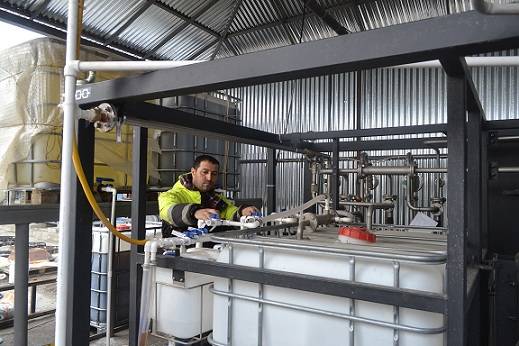Bitumen emulsion manufacturing process

Bitumen emulsion manufacturing
In most cases, bitumen emulsions are prepared in the KLM colloid mill. The mix of hot bitumen and water phase passes between the rotor and the stator. Both parts have a complex relief to create additional turbulence.
The following types of units for bitumen emulsion manufacturing are available today, batch and continuous.
Bitumen emulsion manufacturing process consists of two stages: first, preparation of the water phase, and then emulsion production. The water phase is prepared in a special tank with water, emulsifier, acid (or alkali) and other additives. The solution is thoroughly mixed. When emulsion is produced, the pre-mixed water phase is injected into the bitumen.
In the batch process, the production involves a small amount of components and can be controlled manually. Quality of the emulsion is defined by the precision of component dosage. Hence the need to automate the process.
The need for closed dosage system is dictated by the environmental and health hazards of the chemicals involved.
The continuous process involves heating of water and dosage of all components continuously by a separate pump for each of the components. Consumption tanks are not required. This process requires automation with precise control of material dosage, apart from acid, which is dosed based on the indications of the water phase pH meter.
The UVB-2 plants allow modification of bitumen emulsions by various polymers, such as latex, and SBS. During emulsification. bitumen is atomized into microscopic particles that are prone to coalesce. Good emulsion requires correct application of mechanical energy to reduce the size of bitumen particles and prevent their coalescence after dispersion.
The size of the particles is defined by the colloid mill, the duration of the component’s presence in the mill, concentration and type of emulsifier and the temperature of the emulsification.
The viscosity of bitumen during emulsification should not exceed 500 cSt. If this parameter is not met, bitumen must be heated before entering the mill.
The water phase may also be heated for better solution of surfactants to 30-70ºС. The exact process of emulsifier stabilization is defined by the hydrophilic nature of the surfactant. If the emulsifier contains a large hydrophilic group, coagulation of bitumen particles may be prevented. However, the most important thing is that hydrophilic groups can form a film of the same charge on the surface of bitumen particles, pushing them apart.

